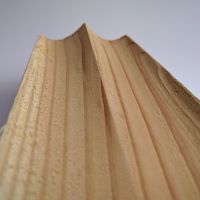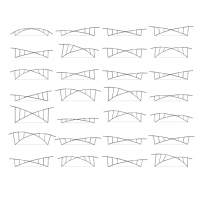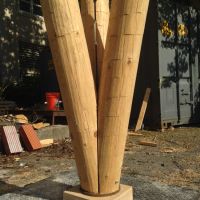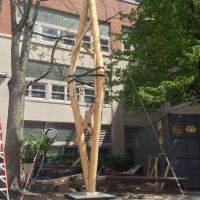Tag: embodied-carbon
-
 Computational Structural Design and Fabrication of Hollow-Core Concrete BeamsMohamed Ismail, Caitlin Mueller, IASS Symposium 2018: Creativity in Structural Design, 2018
Computational Structural Design and Fabrication of Hollow-Core Concrete BeamsMohamed Ismail, Caitlin Mueller, IASS Symposium 2018: Creativity in Structural Design, 2018The paper presents the results of the design method for a simply supported cavity beam, along with fabrication and load testing results. An optimization algorithm determines the location and rotation of empty plastic water bottles within a prismatic reinforced concrete beam in order to reduce material usage without reducing strength. Designed for India’s affordable housing construction, the beam is constrained by the fabrication methods and materials available to India’s construction industry. This is an effort to merge structural design tools with the development of affordable housing technology, potentially reducing the economic and environmental cost of construction through material efficiency. The designed beam results in a theoretical concrete volume reduction of 16%. Two cavity beams are designed and constructed, and then load-tested in comparison to two solid beams with the same dimensions.
-
 Structural Optimization of Cross-Laminated Timber PanelsPaul Mayencourt, Irina Rasid, and Caitlin Mueller, IASS 2018 Symposium, 2018
Structural Optimization of Cross-Laminated Timber PanelsPaul Mayencourt, Irina Rasid, and Caitlin Mueller, IASS 2018 Symposium, 2018Cross-Laminated Timber (CLT) panels are gaining considerable attention in the United States as designers focus on building more ecological and sustainable cities. These panels can speed up construction on site due to their high degree of prefabrication, and consequently, CLT is deployed for slab systems, walls and composite systems in modern buildings. However, the structural use of the material is inefficient in CLT panels. The core of the material does not contribute to the structural behavior and acts merely as a spacer between the outer layers. This project offers an alternative design of an optimized CLT panel with the goal of reducing material consumption and increasing the efficiency of this building component, which can help it become more ubiquitous in building construction.
In this paper, a theoretical model for the behavior of optimized CLT panels is developed, and this model is compared with scaled physical load tests. The results demonstrate that the theoretical model accurately predicts physical behavior. Furthermore, around 20 % of material can be saved without major change in the structural behavior. The reduced material consumption and cost of the proposed optimized CLT panels can help mitigate the ecological impact of the construction industry, while offering a new competitive building product to the market. -
 Minimizing Embodied Carbon in Multi-Material Structural Optimization of Planar TrussesResearch, 2016 - 2018
Minimizing Embodied Carbon in Multi-Material Structural Optimization of Planar TrussesResearch, 2016 - 2018Material type and quantity are important in determining the embodied carbon emissions for a buildings because both will affect the amount of carbon emitted from the material production. In particular, structural systems such as long-span trusses contribute a substantial amount to a buildings' total embodied carbon, and are the focus on this work. Two common materials for truss structures are timber and steel. While timber’s embodied carbon coefficient and density are lower than that of steel, its much lower strength means that it may not always result in the least carbon emitting structural design. As a result, the choice of the more sustainable material for any given member is dependent on factors such as the truss span or shape. Multi-material structures offer a solution to create structurally efficient structures with lower environmental impact. This embodied carbon optimization investigates truss structures of various spans using parametric modeling and numerical optimization, and studies how multi-material and single-material designs compare. This research introduces a new approach for multi-material designs for the optimization of embodied carbon and demonstrates the advantages of using structural optimization and multi-material designs for sustainability.
-
 Caitlin Mueller and Paul Mayencourt present at NESEA Build Energy Boston2018-03-09, Tags: conceptual-design embodied-carbon
Caitlin Mueller and Paul Mayencourt present at NESEA Build Energy Boston2018-03-09, Tags: conceptual-design embodied-carbonCaitlin Mueller and Paul Mayencourt will present in a panel at the NESEA conference on March 9th on Material Choice and Climate Change on environmental impact of building materials.
-
 Computational Structural Optimization and Digital Fabrication of Timber BeamsResearch, 2016 - Present
Computational Structural Optimization and Digital Fabrication of Timber BeamsResearch, 2016 - PresentStructural optimization techniques offer means to design efficient structures and reduce their impact on the environment by saving material quantities. However, until very recently, the resulting geometrical complexity of an optimized structural design was costly and difficult to build. Today, fabrication processes such as 3D printing and Computer Numeric Control (CNC) machining in the construction industry reduces the complexity to produce complex shapes.
This research aims to combine computational structural optimization and digital fabrication tools to create a new timber architecture. A key opportunity for material savings in buildings lies in ubiquitous structural components in bending, especially in beams. This research explores old and new techniques for shaping structural timber beams.
-
 Paul Mayencourt presents at Wood at Work Montreal2017-10-27, Tags: computation fabrication digital-manufacturing embodied-carbon structural-optimization timber
Paul Mayencourt presents at Wood at Work Montreal2017-10-27, Tags: computation fabrication digital-manufacturing embodied-carbon structural-optimization timberPaul Mayencourt presented research on opportunities for using structural optimization and digital fabrication to shape wood structural beams and building components at the third annual Wood at Work conference in Montreal.
-
 Caitlin Mueller to join panel for C3E Women in Clean Energy Symposium2017-11-14, Tags: embodied-carbon energy
Caitlin Mueller to join panel for C3E Women in Clean Energy Symposium2017-11-14, Tags: embodied-carbon energyAs part of the 2017 C3E Women in Clean Energy Symposium, Caitlin Mueller will join a panel discussion focused on enabling technologies for a clean energy future on Wednesday, November 15.
-
 Low-Cost, Low-Carbon Structural Components for Housing in IndiaResearch, 2017 - Present
Low-Cost, Low-Carbon Structural Components for Housing in IndiaResearch, 2017 - PresentIn More Economically Developed Countries (MEDCs) such as the United States, labor costs constrain affordable construction. As a result, architects and engineers design with systems that reduce the time and complexity of assembly – making use of standardized structural components, nominal sizing, and elements that are not materially efficient or optimal for estimated loading conditions. On the other hand, in Lower Economically Developed Countries (LEDCs) material costs, rather than labor, inhibit affordable construction. Conservatively, materials account for an estimated 60-80% of construction costs in LEDCs such as India. This incongruity highlights an opportunity for structural components optimized for material efficiency and suit the context of a developing LEDC such as India.
This research explores the design of structural components and standards that could be disseminated by partners involved in India’s affordable housing construction. It is an application of emerging technology and practices in structural optimization. The exploration will involve not only defining ideal structural forms, but also designing the mechanisms required to build and assemble these components – reducing the environmental and economic costs of construction through the entire process of realization. This research is being done with the support and guidance of the MIT Tata Center.
-
 Optimization for structural performance and energy usage in conceptual building designNathan Brown and Caitlin Mueller, Presentation at the 2015 Engineering Mechanics Institute Conference, 2015
Optimization for structural performance and energy usage in conceptual building designNathan Brown and Caitlin Mueller, Presentation at the 2015 Engineering Mechanics Institute Conference, 2015A traditional goal of structural optimization has always been material reduction, which can lower both the cost and embodied energy of a design. However, when structural optimization is applied to buildings, the relationship between embodied energy of the structure and operational energy of the building is often ignored. In many cases there are clear tradeoffs between the two that can be seen even in conceptual design. In order to use optimization methods to explore the trade-offs between structure and energy usage, a translation and conversion must take place between the “sticks” analyzed by structural software and the “surfaces” analyzed by energy modeling software. Once this translation has been made, it is possible to explore different conceptual designs with reference to their structural and energy usage performance. It is also possible to scale the structural performance score by embodied energy to understand the relative importance of these different design objectives in term of a single unit – emissions.
In this talk, we present a number of case studies in which a conceptual architectural design is optimized with the multiple objectives of structural efficiency and minimized operational energy usage. The designs are first developed and parameterized using the geometric drawing software preferred by architects, and then analyzed by FEM and energy simulation programs that easily plug into this design environment. In a multiple-objective optimization problem in an architectural context, important tradeoffs occur and designers may exhibit preferences in different areas. For this reason, the rapid generation and evaluation of conceptual design alternatives in terms of both structure and operational energy gives the designer an opportunity to optimize towards a diverse range of high performing solutions. These case studies suggest a more generalized process for pursuing multiple-objective optimization in conceptual building design, which lays the groundwork for a potentially valuable tool for architectural and structural designers. -
 New Structural Systems in Small-Diameter Round TimberAurimas Bukauskas, MIT BSA Thesis, 2015
New Structural Systems in Small-Diameter Round TimberAurimas Bukauskas, MIT BSA Thesis, 2015Trees, when used as structural elements in their natural, round form, are up to five times stronger than the largest piece of dimensioned lumber they could yield. Additionally, these whole-timbers have a lower effective embodied carbon than any other structural material. When combined into efficient structural configurations and joined using specially-engineered connections, whole- timber has the potential to replace entire steel and concrete structural systems in large-scale buildings, bridges, and infrastructure. Whole-timber may be the most appropriate structural solution for a low-carbon and fully renewable future in both developed temperate regions and the developing Global South. To reduce barriers to adoption, including project complexity and cost, a standardized “kit of parts” in whole-timber is proposed. This thesis proposes new designs for the first and most important element of this kit: a structurally independent column in whole-timber. A 20’ compound column in whole-timber is prototyped at full-scale. New, simple calculation methods are developed for estimating the buckling capacity of tapered timbers. Based on conservative assumptions, the embodied carbon of whole-timber column systems is shown to be between 30% and 70% lower than conventional steel systems.
-
 Whole-timber structural systemsResearch, 2014 - 2015
Whole-timber structural systemsResearch, 2014 - 2015Trees, when used as structural elements in their natural, round form, are up to five times stronger than the largest piece of dimensioned lumber they could yield. Additionally, these whole-timbers have a lower effective embodied carbon than any other structural material. When combined into efficient structural configurations and joined using specially-engineered connections, whole-timber has the potential to replace entire steel and concrete structural systems in large-scale buildings, bridges, and infrastructure. Whole-timber may be the most appropriate structural solution for a low-carbon and fully renewable future in both developed temperate regions and the developing Global South. To reduce barriers to adoption, including project complexity and cost, a standardized “kit of parts” in whole-timber is proposed. This project proposes new designs for the first and most important element of this kit: a structurally independent column in whole-timber. A 20’ compound column in whole-timber is prototyped at full-scale. New, simple calculation methods are developed for estimating the buckling capacity of tapered timbers. Based on conservative assumptions, the embodied carbon of whole-timber column systems is shown to be between 30% and 70% lower than conventional steel systems.


